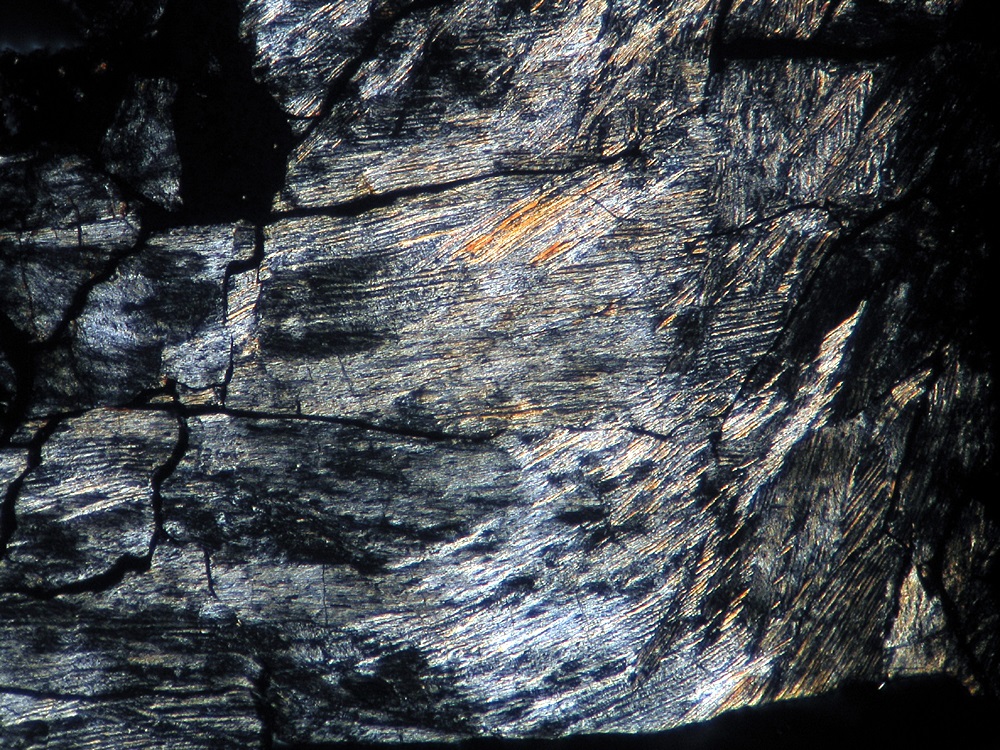| |
Click here to view this video directly on YouTube
|
|
|

|
|
Photo and video by John Kashuba.
|
What is a thin section? What do all the colors mean?
|
Thin section. CBa
TKW 3.95 kg. Observed fall in Nahr an Nil, Nubian
Desert, Sudan.
From the MetBul:
Observed fall 7 October 2008, 05:46 h local time (UT+3)
On October 6, 2008, a small asteroid called 2008 TC3 was discovered by the automated Catalina Sky Survey 1.5 m telescope at Mount Lemmon, Tucson, Arizona, and found to be on a collision course with Earth. Numerous astronomical observatories followed the object until it entered the Earth’s umbra at Oct. 7.076 UTC the next day. The astrometric position of 295 observations of 2008 TC3 over the period Oct. 6.278 to Oct. 7.063 was used to calculate the approach trajectory over the impact location in northern Sudan. The object exploded at a high ~37 km altitude over the Nubian Desert, and as a result the meteorites are spread over a large area. A search was organized by the University of Khartoum on Dec. 2–9, led by P. Jenniskens (SETI Institute) and M. H. Shaddad (Khartoum).
There have been many stones from this fall classified, with a wide variety of results - Ureilite, polymict, anomalous; bencubbin; EH 4/5; EL 3; and CBa.
John Kashuba writes:
The first carbonaceous chondrite sample from Almahata Sitta is MS-181, a 58.6 gram rock that is about 60% metal. We were lucky to get a (very small) slice that is partially silicate. In thin section it displays a texture that researcher A. Bischoff describes as something between barred-pyroxene and radial-pyroxene.
These photos are of an area about 3mm wide viewed in cross-polarized light. The thin laths look similar to those in RP chondrules. But when the sample is rotated it is hard to see any progressive optical extinction as we see in RP chondrules.
Visit my Web Site |
Click to view larger photos
#1
|
Found at the arrow (green or red) on the map below
View Larger Map |
|
| |
Anne Black
5/29/2016 1:11:31 AM |
Thank you! I am glad you liked it. |
Wilford Krantz
5/28/2016 10:20:35 PM |
Cool video! The rotation is very instructive, demonstrating clearly what "cross polarization" is all about. There is no such thing as cross polarized light. Rather, the method uses crossed polarized filters which yield black. The various crystal elements in the TS add their own polarization angles which change the black to characteristic colors. |
John Divelbiss
5/28/2016 3:08:14 PM |
The structure, though much smaller in these section views, is visually similar to natural Asbestos found in gneisses. Interesting views and overall subject matter from this particular sample. A.S. is one strange Fall. |
Graham Macleod
5/28/2016 7:08:56 AM |
I agree M8,
This is a stunning graphic of a most remarkable meteorite!
Thanks Anne. |
Graham
5/28/2016 3:48:15 AM |
This meteroite continues to amaze me.
|
| |
|